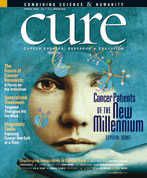Publication
Article
CURE
v4n4 - Classifying NHL Aids in Treatment Choices
Author(s):
Because many treatment options exist for non-Hodgkin’s lymphoma, separating the illness into subgroups is important. Past classification systems separated NHL by appearance or how fast it grew, but the more recent system from the World Health Organization categorized more than 20 NHL subtypes by chemical and genetic information, making it easier to diagnose and treat each disease class.
In the past, doctors didn’t understand why combination chemotherapy worked on only 40 percent of patients with diffuse large B-cell lymphoma, one of the most common types of NHL. Gene expression profiling answered this question when separate groups were found, including germinal center B-cell-like and activated B-cell-like. The five-year survival rate of patients with activated B-cell-like lymphoma is less than half that of patients with germinal center B-cell-like lymphoma. Because patients with activated B-cell-like lymphoma have a lower survival, aggressive or investigational treatments, including high-dose chemotherapy with stem cell transplant, are considered earlier in the course of therapy.
Genetic information used to classify NHL can be very specific. Mantle cell lymphoma, which only accounts for about 5 percent of NHL cases, is characterized by overexpression of the cyclin D1 protein, translocation of genes on chromosomes 11 and 14 and presenting CD5 antigen on B cells. Historically, this disease has been very resistant to treatment. However, phase II data recently published in the Journal of Clinical Oncology has shown activity with Velcade in patients with relapsed mantle cell lymphoma.
Researchers have struggled for years to classify, diagnose and treat the various types of NHL. Gene profiling will contribute to the increasing number of NHL subtypes, but it will also help in diagnosis and treatment for individual patients.






